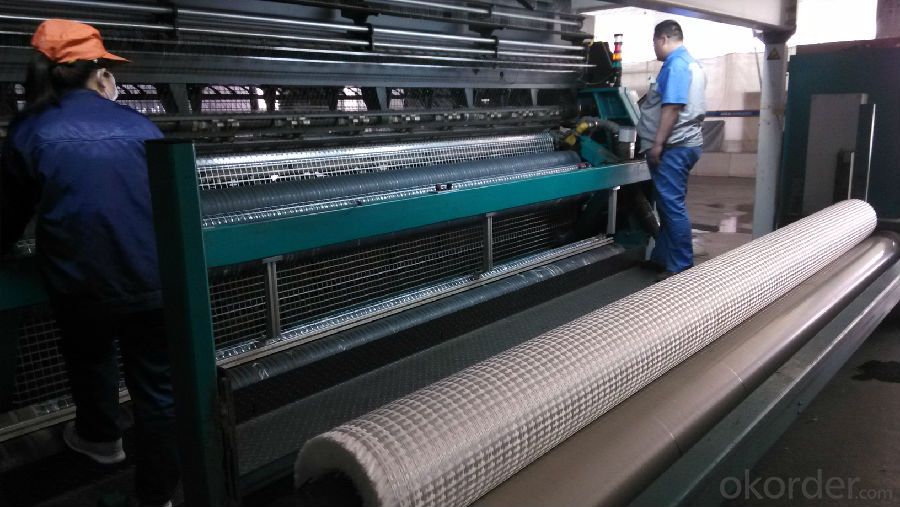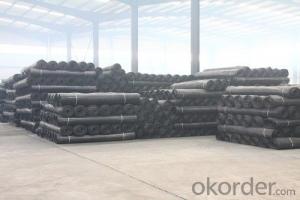Fiberglass geogrid for River Bank- Hot sell
- Loading Port:
- Qingdao
- Payment Terms:
- TT OR LC
- Min Order Qty:
- 1000 m²
- Supply Capability:
- 1000000 m²/month
OKorder Service Pledge
OKorder Financial Service
You Might Also Like
1.Brief Introduction
Product has high strength, low elongation, high temperature, high modulus , light weight , good toughness, corrosion resistance , long life , etc. , can be widely used in the old concrete pavement , maintenance of airport runways , dams , river banks , while slope protection , road bridge , enhancement engineering field, to the road surface can be enhanced , reinforced to prevent pavement rutting fatigue crack , hot and cold telescopic cracks and reflection cracks below , and can the pavement load stress dispersion , extending pavement life .
2.Characteristics
The high tensile strength low - elongation : Fiberglass geogrid is a glass fiber , while the high tensile strength of glass fiber , more than other fibers and ordinary metals . Its high modulus , high resistance to deformation , elongation at break of less than 3% .
No long-term creep : as a reinforcing material , with the ability to resist deformation under the load in the long-term creep resistance is extremely important, the glass fiber will not creep , to ensure that the products can long-term performance .
3.Application
ysical and chemical stability after special treatment agent coated handle , fiberglass geogrid to resist a variety of physical wear and chemical attack , but also to resist biological erosion and climate change to ensure that its performance is unaffected by the loss .
4.FAQ
good thermal stability : the melting point of glass fibers is above 1000 °C , to ensure the stability of the glass fiber geogrids to withstand high temperature in a paving job .

- Q:Can fiberglass fabric be used for making clothing?
- Yes, fiberglass fabric can be used for making clothing. However, it is not commonly used due to its properties such as being scratchy, non-breathable, and potentially causing skin irritation.
- Q:Is fiberglass fabric resistant to chemicals used in pharmaceutical industry?
- Yes, fiberglass fabric is generally resistant to the chemicals used in the pharmaceutical industry. Its non-reactive nature and high chemical resistance make it suitable for use in various pharmaceutical applications such as filtration, insulation, and protective clothing. However, it is important to note that the specific chemical resistance may vary depending on the type of fiberglass fabric and the concentration and duration of exposure to the chemicals.
- Q:What is the typical lifespan of fiberglass fabrics?
- The lifespan of fiberglass fabrics can vary depending on factors such as fabric quality, usage environment, and maintenance. Generally, fiberglass fabrics are known for being durable and long-lasting, and with proper care, they can last 10 to 30 years or more. Fiberglass fabrics find common use in insulation, construction, and the manufacturing of boats, automobiles, and aircraft. These industries subject the fabrics to harsh conditions, extreme temperatures, and chemical exposure. Despite these challenges, fiberglass fabrics can maintain their structural integrity and performance for a significant period. However, it is important to consider certain factors that can affect the lifespan of fiberglass fabrics. Over time, exposure to UV radiation can cause the fabric to degrade and weaken. Improper handling, excessive abrasion, and lack of maintenance can also shorten the lifespan. To maximize the lifespan of fiberglass fabrics, it is recommended to regularly inspect, clean, and maintain them. This involves keeping the fabric clean, avoiding excessive abrasion or impact, and promptly repairing any damages or tears. Additionally, applying protective coatings or treatments can provide extra protection against UV radiation and chemical exposure. In summary, fiberglass fabrics typically last 10 to 30 years or longer, depending on various factors. With proper care and maintenance, they can offer durability and performance for a significant period, making them a reliable choice for industrial and commercial applications.
- Q:What are the different dyeing options available for fiberglass fabric?
- There are several dyeing options available for fiberglass fabric, each with its own advantages and considerations. 1. Pigment dyeing: Pigment dyeing involves adding pigments to the fabric, which bond with the fibers to create color. This method offers a wide range of color options and is relatively easy to use. However, it may not achieve deep or uniform color penetration, and the color may fade over time due to exposure to sunlight and other environmental factors. 2. Solution dyeing: In solution dyeing, the color is added to the liquid before it is turned into fibers. This results in a more permanent and fade-resistant color as the dye is integrated throughout the entire fabric. However, it limits the color options available as the dye must be added during the manufacturing process. 3. Disperse dyeing: Disperse dyeing is commonly used for synthetic fibers like fiberglass. It involves dispersing the dye in a carrier liquid and then applying it to the fabric through various methods such as immersion, padding, or spraying. Disperse dyeing offers good color fastness and can achieve vibrant and uniform colors. However, it requires high temperatures and pressure to ensure proper dye penetration. 4. Sublimation dyeing: Sublimation dyeing is a heat transfer process where the dye is converted from a solid to a gas and then back to a solid on the fabric. This allows the dye to bond directly with the fibers, resulting in vibrant and long-lasting colors. Sublimation dyeing offers excellent color fastness and the ability to achieve intricate patterns and designs. However, it requires specialized equipment and is typically more suitable for large-scale production. It is important to note that the dyeing options available may vary depending on the specific type and composition of the fiberglass fabric. Additionally, the choice of dyeing method should consider factors such as the desired color, durability, and application requirements.
- Q:Is fiberglass fabric resistant to chemicals used in oil and gas industry?
- Yes, fiberglass fabric is generally resistant to chemicals used in the oil and gas industry. Its high resistance to corrosion and chemical degradation makes it an ideal choice for applications in this industry.
- Q:Can fiberglass fabrics be used for insulation in industrial machinery?
- Fiberglass fabrics are indeed applicable for insulating industrial machinery. Their remarkable thermal insulation properties stem from their low thermal conductivity. They possess a strong resistance to heat transfer, rendering them an appropriate selection for insulating industrial machinery that functions under high temperatures. Moreover, fiberglass fabrics are non-flammable and exhibit commendable resistance to chemicals, ensuring a secure and enduring choice for insulation in industrial environments. They proficiently capture heat and prevent energy dissipation, thereby enhancing the overall efficiency and performance of the machinery. All in all, fiberglass fabrics prove to be a dependable and efficient alternative for insulating industrial machinery.
- Q:How does fiberglass fabric perform in wind and storm conditions?
- When it comes to wind and storm conditions, fiberglass fabric is renowned for its outstanding performance. Its strength and durability enable it to resist wind damage and endure high wind speeds. The fabric's unique composition, consisting of intertwined glass fibers, grants it remarkable strength and stability, making it highly effective in withstanding the forces of strong winds and storms. One of the main advantages of fiberglass fabric in wind and storm conditions lies in its ability to maintain its shape and structural integrity. Unlike other materials that may distort or collapse under heavy wind loads, fiberglass fabric remains rigid and stable, ensuring the protection of structures or objects it covers. Furthermore, fiberglass fabric exhibits high resistance to moisture, which makes it an optimal choice for windy and stormy environments. It does not absorb water, preventing it from becoming cumbersome and losing its effectiveness. This characteristic also serves to prevent the growth of mold or mildew, which could compromise the fabric's performance. Moreover, fiberglass fabric possesses fire-resistant properties, which are crucial in storm conditions where the risk of fire is elevated. This fire-retardant attribute provides an extra layer of safety, making it the preferred choice for applications expected to face wind and storm conditions. To sum up, fiberglass fabric excels in wind and storm conditions. Its strength, stability, resistance to moisture, and fire-retardant capabilities make it an excellent option for various applications, including protective covers, building structures, and outdoor equipment. It ensures durability and safety even in the most severe weather conditions.
- Q:How is fiberglass fabric used in the production of protective gloves?
- Protective gloves commonly utilize fiberglass fabric because of its unique properties that make it an ideal material for safeguarding against different dangers. Comprised of fine glass fibers woven together, this fabric is both strong and durable. An outstanding advantage of fiberglass fabric in protective gloves is its superb heat resistance. With the ability to withstand high temperatures without melting or deteriorating, it is well-suited for situations where heat protection is crucial. In industries like welding, metalworking, or firefighting, where workers face extreme heat or flames, these gloves made of fiberglass fabric offer a reliable barrier against thermal hazards. Moreover, fiberglass fabric is highly resistant to cuts, abrasions, and punctures. This quality is especially important in industries such as construction, manufacturing, or automotive, where workers handle sharp objects or operate machinery that poses injury risks. The gloves' durability ensures they can endure the demands of these environments, preventing cuts or punctures and providing dependable protection for the wearer. Another benefit of fiberglass fabric is its ability to resist chemical exposure. Many industrial jobs involve handling hazardous chemicals or substances that can cause skin irritation or burns. Fiberglass fabric gloves act as an effective shield against these chemicals, preventing direct contact and reducing the risk of harm. In addition, fiberglass fabric gloves are lightweight and flexible, offering dexterity and ease of movement. This is particularly vital in industries where workers require precise hand movements, such as electronics, precision engineering, or laboratory work. The gloves allow the wearer to maintain control and grip while still providing necessary protection. To summarize, fiberglass fabric is utilized in the production of protective gloves because of its exceptional heat resistance, cut and puncture resistance, chemical resistance, and flexibility. By harnessing these properties, fiberglass fabric gloves ensure the safety of workers in various industries, guarding them against thermal hazards, cuts, abrasions, chemical exposure, and enabling precise hand movements.
- Q:What is the difference between glass fiber plain cloth and glass fiber grid cloth? What are the specifications and specifications of plain cloth and square cloth?
- Glass fiber plain woven fabric refers to the warp and weft at 90 angles up and down weaving woven fabric. In the glass fiber industry, usually spinning (monofilament diameter less than 9 microns) to weave. In addition to the plain method, can also use different weave twill or satin weave etc..
- Q:Are fiberglass fabrics resistant to tearing or puncturing?
- Yes, fiberglass fabrics are known for their high resistance to tearing and puncturing.
1. Manufacturer Overview |
|
|---|---|
| Location | |
| Year Established | |
| Annual Output Value | |
| Main Markets | |
| Company Certifications | |
2. Manufacturer Certificates |
|
|---|---|
| a) Certification Name | |
| Range | |
| Reference | |
| Validity Period | |
3. Manufacturer Capability |
|
|---|---|
| a)Trade Capacity | |
| Nearest Port | |
| Export Percentage | |
| No.of Employees in Trade Department | |
| Language Spoken: | |
| b)Factory Information | |
| Factory Size: | |
| No. of Production Lines | |
| Contract Manufacturing | |
| Product Price Range | |
Send your message to us
Fiberglass geogrid for River Bank- Hot sell
- Loading Port:
- Qingdao
- Payment Terms:
- TT OR LC
- Min Order Qty:
- 1000 m²
- Supply Capability:
- 1000000 m²/month
OKorder Service Pledge
OKorder Financial Service
Similar products
New products
Hot products
Related keywords





























